The MGA With An Attitude
DOOR LATCH Repair, Ratchet Star Wheel #3 - CP-113E3
This article furnished by Bob Krzywicki in Arlington, Virginia, USA.
For some reason my passenger side door would sometimes not engage the striker plate when i went to close the door. It seemed the pinion peak would strike the striker plate and not rotate. My initial thought was that it was indexed wrong but I never really put it all together. After spending lots of time fiddling with the striker plate I went into the door cavity to remove the door lock mechanism, since there was nothing left to adjust. I was not sure what I was seeing, and I conferred with David Adams who helped me figure out my other lock, and we discovered something very interesting.


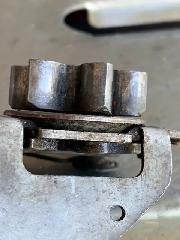
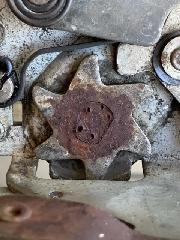 It didn't jump out at us at first but we soon realized that the star wheel valleys looked different then a normal MGAs star wheel and the relationship of the star wheel valleys to the pinion valleys were different. The MGA valleys were smooth and radiused David called it "lazy" and mine were angular.
It didn't jump out at us at first but we soon realized that the star wheel valleys looked different then a normal MGAs star wheel and the relationship of the star wheel valleys to the pinion valleys were different. The MGA valleys were smooth and radiused David called it "lazy" and mine were angular.
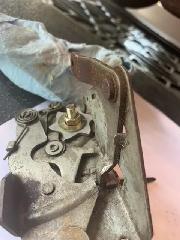
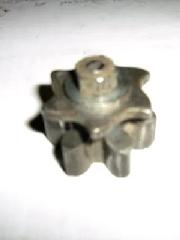 Here is a picture of David's pinion and star wheel from Barneys website CP-113E. You can see that the star wheel peak is lined up to the pinion valley. David called a a valley/peak relationship, mine had a peak/peak relationship, and the difference meant that the pinion peak was striking the striker when it should have been the valley being in that location
Here is a picture of David's pinion and star wheel from Barneys website CP-113E. You can see that the star wheel peak is lined up to the pinion valley. David called a a valley/peak relationship, mine had a peak/peak relationship, and the difference meant that the pinion peak was striking the striker when it should have been the valley being in that location
 But WHY and HOW did this get happen? The fix was easy enough once we realized what was going on. I had to re-index the star wheel to the pinion and did this by grinding the Double D shaft and pressing the star wheel on, putting it back in the door and then testing it. It took me two filings to get the relationship right, but when indexed properly it worked exactly as it was suppose to. I just need to get the thrust washer and I can finish the repair. But WHY and HOW did this get happen? The fix was easy enough once we realized what was going on. I had to re-index the star wheel to the pinion and did this by grinding the Double D shaft and pressing the star wheel on, putting it back in the door and then testing it. It took me two filings to get the relationship right, but when indexed properly it worked exactly as it was suppose to. I just need to get the thrust washer and I can finish the repair.
But the question remained where did this pinion gear and different star wheel come from? The pinion gear was a mm smaller in thickness and had a bevel cut on the inside of the wheel and was indexed wrong. I had recalled seeing this mechanism previously at a car show but could not remember the car, so I started the searching. Not British cars from the 1950s, but a wider search of 1950 door locks wielded the results. 1950-1954 Ford/Mercury door latch listed on eBay as 1950 Mercury 4-door rear latch pair, 0M-7426412, 0M-7426413.
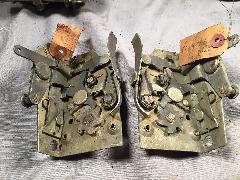
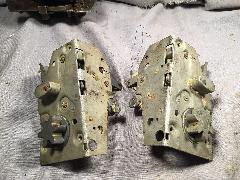
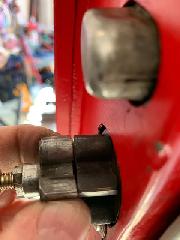
I just picked up the thrust washer so its time to go to work. David Adams notes indicated it should be hardened thrust washer 1.406 OD, 0.625 ID. .020 thick. i got close with 1.0 OD, 0.625 ID, .020 thickness, and its hardened so that's what I am using. Here's the pinions side by side. Funny if you think about it since an MGA door is not close to the weight of a 1950s mercury door.
Here's how I drilled the hole in the pinion. The socket gave me 90* sides and machined flat surfaces. I scribed the pinion peaks and used center punch to mark the hole. I kept aligning the vise with the socket and pinion so that the drill press bit didn't drift when i lowered it. I put a slight mushroom cap on the welded shaft
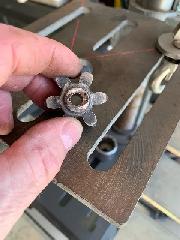

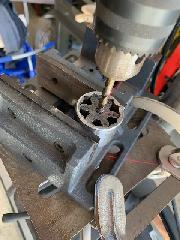
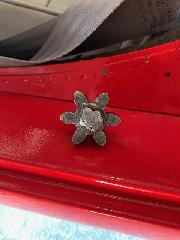
This star wheel repair was a little more difficult since I had to re-index the star wheel to the pinion gear. Where previously I welded the washer to the star wheel outside of the lock mechanism, with this lock I needed to see the star washer on the double D shaft before I obscured the view with the washer. Doing this inside the lock mechanism didn't give me much room for the TIG torch, so I decided to use the MIG welder. Less pretty welds, but you can really direct the moment or two of heat and wire. Not the prettiest of welds but its not going any where. pretty much the same methodology as the previous repair on the drivers side.
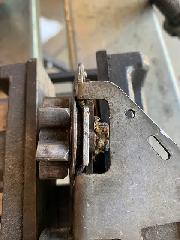
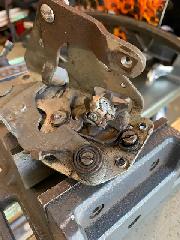
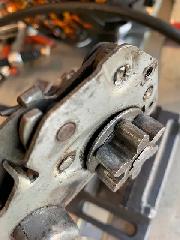
If you are a purist stop reading at this point. On the drivers side door the lever arm from the inside door release handle to the latch mechanism had a bolt where a rivet once was. Removing the nut and bolt let the latch mechanism come out really easily. This car still had the rivet which meant a lot of work to get the latch out. Two minutes with my reciprocating saw, and it no longer had the rivet. Add an access hole and you have a pretty easy way to get the latch mechanism in and out. And I mean super easy, less then a minute to get the latch/lock mechanism out once the lever arm bolt is removed. The rivet can be seen before I drilled it out, and that carriage bolt and nut was there and replaced an original rivet, I used Nyloc nuts for both spots.
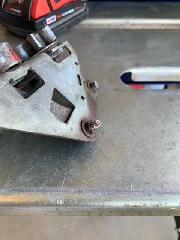
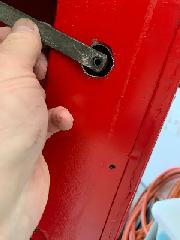
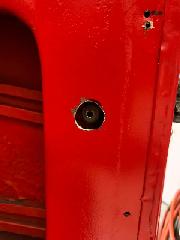
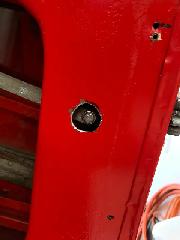
The door works great. I couldn't have done it with out David Adams helping me figure out what was going on. And the Ford/Mercury pinion and star wheel are definitely an option, and those parts are cheap. Today on eBay $30 "buy it now" gets them and includes shipping for both door latches.
|